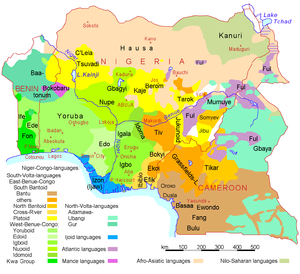伊博语
| 伊博语 | |
|---|---|
| Igbo | |
| 发音 | [iɡ͡boː] |
| 母语国家和地区 | 尼日利亚东南部 |
| 区域 | 尼日利亚 |
母语使用人数 | 2000万-3500万 |
| 语系 | |
| 标准形式 | 标准伊博语[1]
|
| 分支/方言 | Waawa, Enuani, Ngwa, Ohuhu, Etche, Olu, Ika, Obigbo, Anioma, Edda, Ukwuani, Ikwerre, Ezaa, Izzi, Ekpeye, Ohafia, Abam [2] |
| 文字 | 拉丁字母 (泛尼日利亚字母) Nwagu Aneke字母 新恩西比底文字 Ndebe字母 伊博语盲文 |
| 官方地位 | |
| 作为官方语言 | |
| 承认少数语言 | [3] |
| 管理机构 | 伊博语言与文化促进会 (SPILC) |
| 语言代码 | |
| ISO 639-1 | ig |
| ISO 639-2 | ibo |
| ISO 639-3 | ibo |
| Glottolog | nucl1417[4] |
| 语言瞭望站 | 98-GAA-a |
 | |
伊博语(Asụsụ Igbo,古语为Ibo),又译作伊格博语,是一种通行于西非国家尼日利亚的伊博族语言,属于尼日尔-刚果语系的大西洋语支,有主要语言人口1800万[5]。伊博语是一种重视声调的语言,在英国殖民时代引进了书写系统,以拉丁字母来构字。伊博语之下有超过20种方言。1972年出现了标准语,基于奥韦里及乌穆阿希亚的地区方言发展而成,但是其中的鼻化元音及送气等特征在标准化的过程中消失了。
除了伊博语外,伊博族语言中还存在许多分支,其中最主要的是埃佩耶语(Ekpeye)。除了伊博语之外,伊博族语言也有其他形成标准语的语言,如伊卡语(Ika)。
语法
[编辑]语序
[编辑]伊博语的语序如下[6]:
动词
[编辑]伊博语的动词会与“不可分代词”连用;另外伊博语的一些词缀与词干有母音和谐的现象。[7]
伊博语的不可分代词用法如下:
- 第一人称单数:动词词干+m
- 第二人称单数:i/ị+动词词干
- 第三人称单数:o/ọ+动词词干
众数形人称代词没有不可分形;第二人称单数和第三人称单数的不可分代词与须对动词词干的母音发生母音和谐;另外使用第一人称单数的不可分代词时,动词词干前方要加前缀a-/e-,该前缀对词干的母音发生母音和谐。
伊博语的否定构造法如下:
- 一般否定形:e-动词词干+ghi/a-动词词干+ghị
- 命令否定形:e+动词词干+ne/a+动词词干+na,使用哪个视词干母音为何而定
以下显示伊博语的动词与代词的用法:
bi(意即“住”)的各种形式:
- ebi m - 我住
- i bi - 你住
- o bi - 他住
- anyị bi - 我们住
- unu bi - 你们住
- ha bi - 他们住
chị(意即“带”)的各种形式:
- chị m - 我带
- ị chị - 你带
- ọ chị - 他带
- anyị chị - 我们带
- unu chị - 你们带
- ha chị - 他们带
否定用例:
- aha m bụ ___ - 我的名字是___
- aha m abụghị ___ - 我的名字不是___
书写系统
[编辑]伊博语的书写系统是一种基于拉丁字母的系统,被称为昂乌字母(Onwu /oŋwu/ Alphabet)。以下为昂乌字母与其相对应之IPA符号的对照:
| 伊博语字母 (Onwu) |
IPA | 伊博语字母 (Onwu) |
IPA | |
|---|---|---|---|---|
| a | /a/ | ọ | /ɔ/ | |
| b | /b/ | p | /p/ | |
| gb | /ɓ/ ~ /ɡ͡b/ | kp | /ɓ̥/ ~ /k͡p/ | |
| d | /d/ | r | /ɾ/ | |
| e | /e/ | s | /s/ | |
| f | /f/ | sh | /ʃ/ | |
| g | /ɡ/ | t | /t/ | |
| gh | /ɣ/ | u | /u/ | |
| h | /h/ | ụ | /ʊ/ | |
| i | /i/ | v | /v/ | |
| ị | /ɪ/ | w | /w/ | |
| j | /ʤ/ | y | /j/ | |
| k | /k/ | z | /z/ | |
| l | /l/ | ch | /ʧ/ | |
| m | /m/ and /m̩/ | gw | /ɡʷ/ | |
| n | /n/ and /n̩/ | kw | /kʷ/ | |
| ṅ | /ŋ/ | nw | /ŋʷ/ | |
| o | /o/ | ny | /ɲ/ |
The graphemes <gb> and <kp> are described both as implosives and as coarticulated /ɡ/+/b/ and /k/+/p/, thus both values are included in the table.
<m> and <n> each represent two phonemes: a nasal consonant and a syllabic nasal.
Tones are sometimes indicated in writing, and sometimes not. When tone is indicated, low tones are shown with a grave accent over the vowel, for example <a> → <à>, and high tones with an acute accent over the vowel, for example <a> → <á>.
参考文献
[编辑]引用
[编辑]- ^ Heusing, Gerald. Aspects of the morphology-syntax interface in four Nigerian languages. LIT erlag Münster. 1999: 3. ISBN 3-8258-3917-6.
- ^ Igbo Dialects and Igboid Languages. okwuid.com. 2020-04-22 [2023-08-20]. (原始内容存档于2023-10-31) (美国英语).
- ^ World Directory of Minorities and Indigenous Peoples - : Overview. UNHCR. 20 May 2008 [2012-12-18]. (原始内容存档于13 January 2013).
- ^ Hammarström, Harald; Forkel, Robert; Haspelmath, Martin; Bank, Sebastian (编). Igbo. Glottolog 2.7. Jena: Max Planck Institute for the Science of Human History. 2016.
- ^ (1999 WA)
- ^ 存档副本. [2013-02-11]. (原始内容存档于2013-03-25).
- ^ 存档副本. [2013-02-11]. (原始内容存档于2013-01-26).
来源
[编辑]- Awde, Nicholas and Onyekachi Wambu (1999) Igbo: Igbo-English/English-Igbo Dictionary and Phrasebook New York: Hippocrene Books.
- Emenanjo, 'Nolue (1976) Elements of Modern Igbo Grammar. Ibadan: Oxford University Press. ISBN 978-154-078-8
- Surviving the iron curtain: A microscopic view of what life was like, inside a war-torn region by Chief Uche Jim Ojiaku, ISBN 1-4241-7070-2; ISBN 978-1-4241-7070-8 (2007)
- International Phonetic Association (1999) Handbook of the International Phonetic Association ISBN 0-521-63751-1
外部链接
[编辑]- Ethnologue report on the Igbo language(页面存档备份,存于互联网档案馆)
- Igbo Language Center(页面存档备份,存于互联网档案馆)
- A History of the Igbo Language(页面存档备份,存于互联网档案馆)
- Achebe and the Problematics of Writing in Indigenous Languages
- Uwandiigbo: Learning Igbo on the Internet
- An insight guide to Igboland’s Culture and Language (页面存档备份,存于互联网档案馆)
- Igbo Grammar(页面存档备份,存于互联网档案馆)
